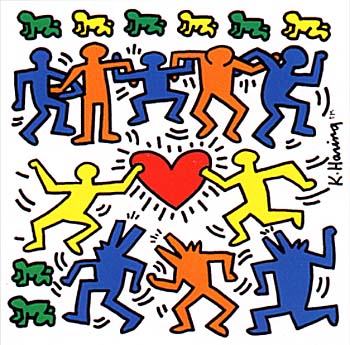
Have you ever observed a piece of art and wondered if there were personal experiences and feelings that prompted the artist into creating it? This is a question that continues to arise among those who view the paintings of contemporary artist Keith Haring. Haring, a Pennsylvania native who died from AIDS at the young age of 31 expressed his own feelings and personal battles of living in New York during the 1980s through his artwork. The art history journal Art in America published an article in April of 1998 that brought to life an exhibit of Haring’s work at the Whitney Museum of American Art. The author, Brooks Adams said that Haring’s work evoked the exuberance both artistic and sexual of 80’s New York, and later went on to explain how Haring seem to include his own personal battles with AIDS in his pieces. Many other Haring “followers” feel the same, including Katherine Dieckmann, a writer for the ArtForum who spoke of the same exhibit. While she seemed to shed a different light on Haring’s work she agreed with Adams that Haring’s work made the observer aware of darker forces (drugs, AIDS, and the cruelty of daily living.) In agreement with these two writers, I feel that the work of Keith Haring has a deeper meaning that most people fail to see.
Brooks Adams, author of “Keith Haring: Radiant Picturesque,” an article in Art in America wrote about Haring’s exhibition in Miami’s Whitney Museum of American Art calling it a “traveling retrospective.” He praised the fact that Haring displayed 80’s New York through subway drawings, paintings, sculptures and historical ephemera. He claimed the exhibition had state-of-the art design and made the observer feel as if they were journeying through a dark labyrinth. As I stated before, Adams seemed to wonder what personal experiences went into Haring’s masterpieces as soon as he entered the introductory room. Adams described it as being the sunny exterior of an American clapboard house which he took to be the Pennsylvania home that Haring grew up. From then on it was as if the author of this article was traveling through the life of Keith Haring. He ended in a long black tunnel which he assumed suggested loneliness and isolation that Haring felt when he was diagnosed with AIDS at the young age of 31. Brooks Adams praised Haring for his daring creations and his ability to reveal his own feelings and experiences through his works. When observing an untitled painting created by Haring in 1982 I was able to recognize this ability of expression. The painting depicts two males embracing one another as if they are in love. Considering Haring’s personal life I assumed that he was expressing his feelings of love towards other men. Haring uses this self-expression in many of his pieces which make them come alive for the observer.
Similarly, Katherine Dieckmann, the author of “Keith Haring - art exhibit at the Whitney Museum, New York,” included in a 1997 issue of ArtForum commended Haring for his work but for other various reasons. Dieckmann described the Haring exhibit as an “array of iconography”, that embraced Haring’s pop passions as a form of libidinal projection and release. She defended Haring against his critics who often said that his work was nothing more than “pleasant downtown wallpaper.” Instead, Dieckmann saw a deeper meaning behind Haring’s decorative obsession. She felt as if Haring’s pieces were calling for widespread alertness and concern. This calling due to the fact that he felt others should become aware of life’s cruelties, including drugs and AIDS. Dieckmann feels others should embrace Haring’s use of effervescence and realism or the point of his work will be missed altogether.
Overall, the work of contemporary artist Keith Haring can be analyzed and compared to his own struggles with life. Through the eyes of two authors from prominent artistic journals it was made known that Haring was only trying to make observers become more aware of the pains and struggles some people must face each day. His use of varying line, shape and iconography helped him to project his own everyday struggle with the AIDS virus and critics should be aware of this before they begin bashing his pieces.
Works Cited:
Adams, Brooks. “Keith Haring: Radiant Picturesque.” Art in America. 86.4 (1998): 94-97 Bibliography of the History of Art. Eureka. University of North Carolina at Chapel Hill, Undergraduate Library. 4 April 2007. http://eureka.rlg.org/Eureka/zgate2.prod
Dieckmann, Katherine. “Keith Haring-Art Exhibit at the Whitney Museum, New York.” ArtForum. (1997) Find Articles. LookSmart. 4 April 2007 http://www.findarticles.com/p/articles/mi_m0268/is_n1_v36/ai_20197592
Keith Haring. The Artists.Org. 4 April 2007 http://www.findarticles.com/p/articles/mi_m0268/is_n1_v36/ai_20197592

No comments:
Post a Comment